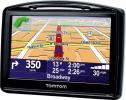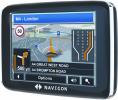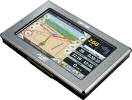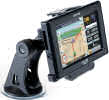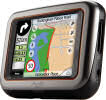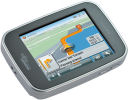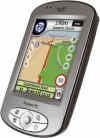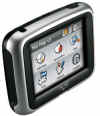Reviews related to : Navigation aids
On the face of it this is just another of the huge range of devices to tell your where you are and how to get to where you are not. However after a few days of use I soon realised it did lots of things that other such devices do not.
The TomTom GO930-T is 11.5x8.5x2cm and has a landscape screen 10.7x5.8cm. While most will of course use it in a car I suggest unless you are a passenger then you first try it on a bus or a train where or course you are a passenger as there is so much to absorb from the screen display and unlike a lot of other units it shows things in different places and often in different ways.
The Navigon 2200 and 2210s are slimline 3.5inch screen GPS units which incorporate traffic information (TMC) and text-to-speech. They are identical with the exception that the 2210 maps cover Europe and not just the UK & Ireland.
I like the very clear print that is used, under the rolling map display, for the names of the road that one is currently on and the road into which one will next turn. However, it was not really needed most of the time as the voice instructions gives the name of the street into which you should turn. This is particularly valuable as it minimises the chance of taking the wrong turning where there are two in close proximity.
Technology can help take some of the strain out of driving by supplying directions through a SatNav device.
Like printers and mobile phones, SatNav devices have started to adopt the mantle of multi-function products. An example of this trend can be seen with the . Along with the main SatNav mapping and directional features, the Mio C520t has audio, image and contact list features plus the ability to link with your mobile phone via Bluetooth connectivity. All this is packed into a device measuring 127 x 81 x 14mm.
Leaving the navigation to others can take some of the strain off driving.
Recently I have noticed a trend with portable peripherals that connect via USB. Instead of providing, as part of the standard package, a power lead to recharge the internal battery via the mains, you have to rely on the USB connection to carry out this function. Maybe this trend can be justified as a cost-cutting exercise but I find it restrictive as I prefer to fully charge such a device in order to check it out before introducing it to my computer.
Having recently looked at the top of the range C520t that seems to do most things. Here is their entry level offering that is exactly what it says a satellite navigation unit.
The unit has one huge plus over it's larger and multifunctional rival, better battery life and should you use it as a cyclist or pedestrian then this is vital. Mio C220 The overall dimensions of the C220 are 10x8x5x2cm and it weights around 150grams. The landscape screen is 7x5.5cm with the largest viewable map area of nearly 5.5cm square when in cockpit mode. Going round the unit the right side has input for an SD card and earbud socket.
This is the top of the range unit from Mio and the size of screen makes it ideal for use in a car. There are modes for pedestrian and bicycle but the size and short battery life make these unsuitable.
Within a few hours of the arriving I had fully charged it and taken it for a drive. To start with without altering any settings it was telling me measurements in metres and finding the switch to change to miles took a while. I noticed with pleasure that there was plenty of volume at the default setting and in fact it had more in reserve. Mio C520t The unit is 12.5x8x2cm and this allows a screen of 10x5.
This is a tiny sat nav system but not only is it for cars etc but also for pedestrians and bicycles. When I say small it fits into the palm of my hand and I do not have enormous hands.
It is 9x6x1.5cm and weights less than 100grams. The screen is 4.5x6cm and is fine apart from when the sun is right on it when mounted in a car. As regular readers will know I always take sat nav systems for at least a couple of journeys on a train.
This is not just something to find you a route or show you a map. Its a very long way from the early Next Base product on a floppy disc, and it now comes on a DVD.
Normally items labelled 2007 would appear early autumn in 2006 but no doubt most people were working on Vista and Office 2007. So as far as I know it first appeared at the very end of January. The installation was quite quick at only 10 minutes, on my machine it consisted of three parts. First an update to Net Framework, then the complete installation of AutoRoute 2007 and finally a text to speech module.
I saw this unit at the Stuff Live show three months ago, it looked the ideal companion for those who walk around in unfamiliar areas. It can also work efficiently in a car.
It is easily small enough to fit in the hand and I used it regularly for over four hours and even longer with only switching to standby mode on a single charge. It is 8.5x6x2 cm and weights only slightly over 100grams. The base has an earbud socket and mini USB - for charging - as well as a neck/wrist strap anchor point. The left side has 'M' menu button.
As a prime target for break-in merchants, it does help if your Sat Nav device can be placed in your pocket when away from the car. The Mio P350 certainly qualifies.
Sat Nav products tend to fall into one of two main categories. There are devices that have been purposely built to provide just the functionality of satellite navigation whether based in a car or used in pedestrian mode. While a second approach, used by certain companies, involves adding satellite navigation capabilities to a third-party device.
I would call it a personal navigation unit as not only can it be fitted in a car but it has a pedestrian mode that lasts a reasonable time between charges.
The unit is small at 10x6x2cm and weights only around 120grams, it easily fits in the palm on my hand. Doing basic things is easy, however making changes to the defaults is not, the PDF manual may be helpful for those wanting to use it as an MP3 player, Photo viewer or even viewing your Contacts. However for changing settings when in Navigation mode it is not good.
This is a Satellite Navigation unit that specifically mentions a pedestrian mode so a lot of my tests were conducted while walking to various places.
It is 11x8x2cm and weights only around 150grams. If you are going to use it outside a vehicle size and weight are both important. One of my first walks was perhaps my most eventful. It was raining so I of course had the unit well protected in a plastic bag and this meant that I could not use an umbrella. I ended up very wet and due to a glitch rather lost.
GPS and I normally do not normally manage a happy relationship, however this unit was something different and from day one we got on.
Often I have a problem finding enough satellites here on more than one occasion I managed 11, yes eleven. You need three to triangulate and normally this unit found at least seven. I would suggest that you switch on a couple of minutes before you leave allowing it good time to seek them out after that even going through tunnels the signal is picked up again seconds after emerging.
Recent research indicates that around six million GPS devices, available from companies such as ViaMichelin, will be sold in the main European countries during 2006.
Currently GPS (Global Positioning System) technology, whereby a person, object or vehicle can be tracked and located to within a few feet using the power of satellites, has a high profile with steadily rising sales of units. Initially GPS navigation software was built into vehicles (rather a costly solution) and then it appeared in PDAs and other mobile devices at a more economic level.
Getting from A to B has never been easier for those taking the GPS route. Navicore has recently updated its product for the intrepid traveller.
Navicore is one of the companies leading the way in making Satnav technology an economic and easy to use proposition. Last year saw the introduction of Navicore Personal and this product has been quickly followed by Navicore Personal 2006 which offers several new features to the basic Satnav features. One aspect of the product that has not changed is Navicore's approach to the technology.
Last week (10/2/06) I told you about the Navigation software supplied on this PDA, now as this is a functioning PDA in its own right I can tell you about it.
The unit is 12.5x7x2cm and weights close to 200grams. It has a nice solid feel and the screen resolution of 240x320 is clear and sharp. It is a PocketPC 2003 unit and the operating system is WinCE 4.20. You have 27.5MB of available RAM. I found battery life a little disappointing especially when using the Marco Polo Navigation software (reviewed 10/2/06).
A Pocket PC PDA with navigation from Marco Polo the unit being sold in the UK by Evesham Technologies. As regular readers will know I do not have a great record with PDA navigation.
This is probably the most mature mapping package for the PC, now it even allows you to link yourself via GPS, just one of the new features for 2006.
SatNav capabilities, MP3 music and digital image viewing come together with the Mio 269+.
You may know where you are going but do you know hot to get there? Perhaps you need to look at GPS.

